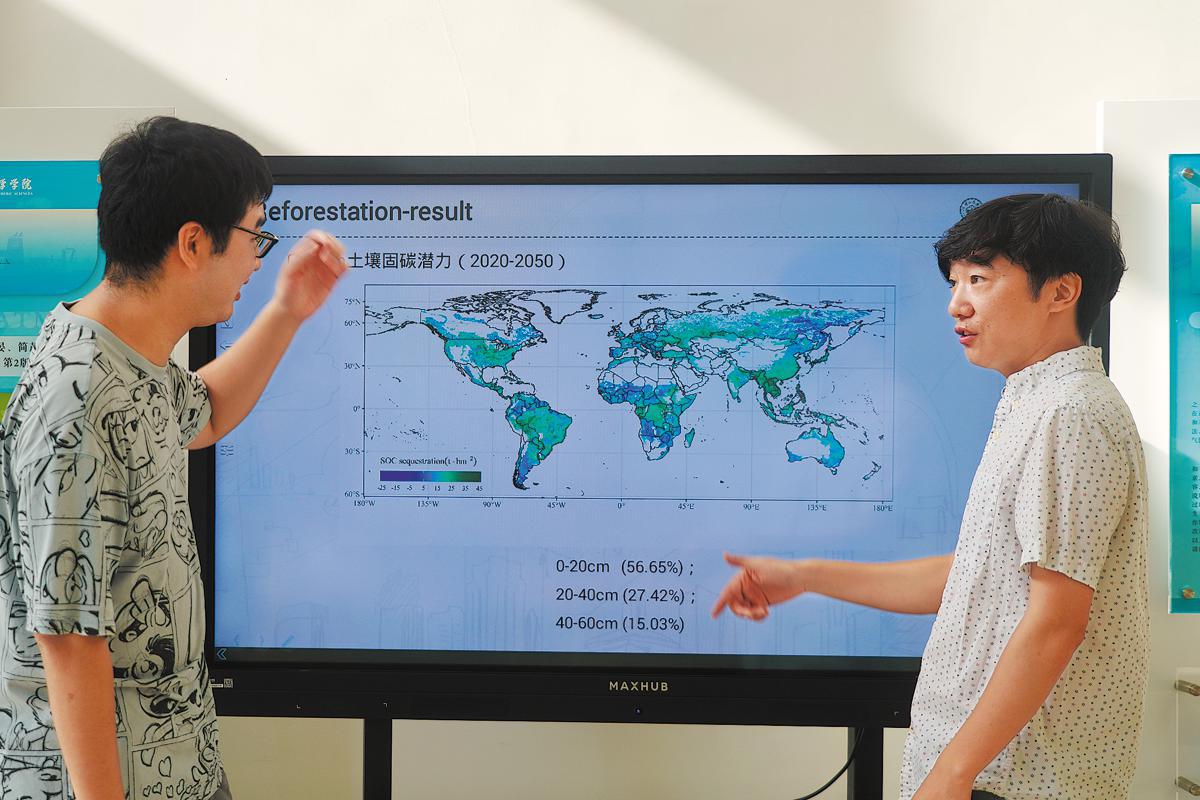 Qin Zhangcai (first from right) leads Wang Yijie (second from right) and two of his students from Sun Yat-sen University in Guangzhou, Guangdong province, to attend an international conference in Austria. (Photo: China Daily)
Qin Zhangcai (first from right) leads Wang Yijie (second from right) and two of his students from Sun Yat-sen University in Guangzhou, Guangdong province, to attend an international conference in Austria. (Photo: China Daily)
To mitigate climate change, afforestation worldwide has the potential to sequester up to 5 billion metric tons of carbon dioxide annually, according to scientific research led by a team from the Sun Yat-sen University in Guangzhou, Guangdong province.
Qin Zhangcai, a professor from the School of Atmospheric Sciences, Sun Yat-sen University, and his team published their findings, titled "Land Availability and Policy Commitments Limit Global Climate Mitigation from Forestation", in the international academic journal Science on Aug 29. The research quantified for the first time the carbon sequestration capacity of underground soil in the global forest restoration process.
To "cool down" the planet, the world is in urgent need of reducing carbon dioxide emissions and enhancing the carbon sequestration capacity of ecosystems. As natural "carbon absorbers", forests serve as indispensable "green air conditioners" for climate regulation, and afforestation is widely regarded as one of the most cost-effective nature-based climate solutions.
The research innovatively integrates three key factors — ecology, climate and policy — to redefine the potential of afforestation to mitigate climate change and provide "navigation" for future global afforestation.
After years of collecting scarce global soil data, Qin's team has successfully developed a machine learning model capable of quantifying soil carbon changes resulting from afforestation. Leveraging international cooperation and integrating existing vegetation carbon estimates, the team has also created an "all-round detector" that can monitor carbon changes in both vegetation and soil.
The team also took into account international environmental and socio-economic constraints related to afforestation, such as biodiversity, water resources, surface warming and national commitments. From the two dimensions of sustainable land "supply" and national policy "demand", the team has redeveloped a "navigation map" for future forest restoration.
"However, when land sustainability and countries' willingness are taken into comprehensive consideration, the actual emission reduction potential of afforestation worldwide can decrease to 1.5 billion metric tons per year," warned Qin, adding that climate risks can stem from "empty talk", or "theoretical plans that lack implementation".
According to Qin, there are huge discrepancies regarding how much carbon dioxide future afforestation can absorb, with the low estimate being less than 300 million tons and the high estimate exceeding three billion tons per year.
Qin said the controversy mainly centers on two key challenges.
While the carbon sequestration capacity of vegetation is relatively clear, changes in soil carbon remain difficult to detect accurately, he said.
 Qin and Wang discuss how to improve their model in the university. (Photo: China Daily)
Qin and Wang discuss how to improve their model in the university. (Photo: China Daily)
"Meanwhile, estimates on land area suitable for afforestation worldwide also differ by 10 times," he said, adding that more importantly, the significant gap between countries' afforestation commitments and their willingness to implement them has long been overlooked.
Qin said there is a huge mismatch between countries' afforestation commitments and land potential. "Countries with land potential have made relatively few commitments, while those that have made more commitments — especially low-income countries — lack sufficient land and other resources to support their afforestation aspirations, he said.
Qin said his team has proposed an Olympics-style goal for global afforestation in the future that is "faster, higher, stronger, and more united".
"We hope the study will provide some scientific reference for global climate change cooperation, helping to clarify issues such as the asymmetry of forest resources among countries and the imbalance of rights and responsibilities between northern and southern countries," he said.
Qin said his team will fully leverage the advantages of international cooperation to conduct research in the intersection of energy, nature, and carbon neutrality, with a focus on exploring feasible natural climate solutions in the years to come.
The editor of Science said Qin's study has comprehensively considered multiple factors and provides a "more realistic" assessment of climate effects.
With Wang Yijie, a doctoral student from the School of Atmospheric Sciences of the university, as the first author of the paper and Qin as the corresponding author, the study was conducted in collaboration with scientists from multiple countries around the world.
China has long been committed to the restoration of forest resources. According to the Master Plan for Major Projects for the Protection and Restoration of Important National Key Ecosystems (2021-35), China has set the goal of achieving a forest coverage rate of 26 percent by 2035 for the 14th Five Year Plan (2021-25).
The net absorption of carbon dioxide by forests around 2010 was approximately 455 million tons per year, and it is expected to further increase to 532-584 million tons per year between 2020 and 2040, reaching a peak of approximately 664-796 million tons per year between 2041 and 2060.
















